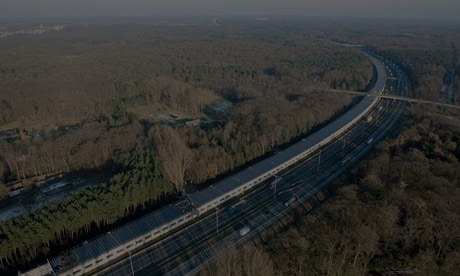The Adani SEZ at Mundra, Gujarat, which houses two mega-power projects based on imported coal, is witnessing a mega-green plan.
Adani Green Energy has set up a 1,200-MW solar cells and modules facility at the SEZ, now up and running to meet the upcoming demand for solar panels.
The one-of-a-kind facility, amidst the fossil fuel-guzzling structures of port, coal plant and other manufacturing units, hints at the paradigm shift India Inc needs to take in re-aligning its energy mix.
Using state-of-the-art technology, including robotics and equipment from world leaders in the solar sector, the facility has generated close to 2,000 jobs.
This unit is all the more remarkable because it comes at a time when cheap Chinese solar panels have become entrenched in the Indian market.
So, though Adani Green Energy executives are confident of their technology matching the global trend, competitive pricing and demand are likely to remain challenges.
Priced some 10 to 20 per cent lower than Indian competitors, Chinese panels have been making their way into India since the beginning of the National Solar Mission in 2010.
Over the past three years, global overcapacity has seen the price of panels crash to 32 cents per kWh from 50 cents per kWh.
No surprise, then, that domestic solar modules manufacturers have approached the Directorate General for Anti-Dumping — for the second time — to levy penalties on Chinese counterparts for dumping ultra-cheap panels in India.
The domestic industry via the Indian Solar Manufacturers’ Association has pleaded for a retrospective duty on importers, arguing that steady imports have considerably damaged the indigenous sector.
The current installed capacity of Indian solar cell manufacturing is around 1,386 MW and that of modules (a packaged connect assembly of solar cells) is close to 2,500 MW. Less than 20 per cent of manufacturing capacity is operational for lack of demand.
Of the total solar power generating capacity, more than 75 per cent is built on imported cells from China, 15 per cent from the US and domestic producers account for the rest.
India’s current solar power installed capacity is 10,000 MW. But the government has set an ambitious target of 100 GW by 2022.

“There was never a time to prepare ourselves to match the growth of solar capacity coupled with the fact that Chinese products entered in the Indian market,” said Tata Power Solar Chief Executive Officer and Executive Director Ashish Khanna.
“We had explosive growth in renewable power generation but that has not taken into consideration the constraints of the manufacturing.”
What constraints? Consultancy Bridge to India offers an answer.
In its latest CEO survey, it mentioned that 55 per cent of the sector’s CEOs feel that poor quality equipment is being dumped in India in response to the sharp fall in prices.
Indeed, more than ₹ 85,000 crore (₹ 850 billion) worth of investments in the country have been dormant on account of cheap Chinese imports, resulting in, as one industry analysis puts it, the creation of a self-inflicted loss-making industry.
Khanna feels imposing duty would hardly help because “the eco-system is still missing for solar manufacturing in India.”
Solar modules typically comes with a performance commitment of 25 years. Quoting international reports, he points out that in one in five companies in China is going off the radar every year. “So there is a possibility that all five of them will go off radar in five years. Where will you catch them?”
Recently, the ministry of new and renewable energy has come out with new standards for equipment used in solar project, including panels.
Touted as a strict quality measure to filter out sub-standard content, both domestic and imported panels will be under its purview.
MNRE has listed six standards for different equipment, including solar panels and batteries used in solar power projects.
The standards are designed under the Bureau of Indian Standards Act and would be governed by it and enforced after 12 months.
“This is a good move that will counter low-quality imports and will be extremely useful in the distributed generation and rooftop segment where the end-user is technically not sophisticated,” said Ratul Puri, chairman, Hindustan Power.
Solar panels
IMAGE: Fifty-five per cent of the solar energy sector’s CEOs feel that poor quality equipment is being dumped in India in response to the sharp fall in prices. Photograph: Kind courtesy International Water Management Institute(IWMI)/ Creative Commons
Meanwhile, the industry is looking for business opportunities.
Initially, a portion of projects under National Solar Mission was reserved for domestic manufacturers, but the World Trade Organisation’s regulations ruled that out.
Tata Power’s Khanna is placing his bets on distributed generation — that is, the generation of small-scale solar energy that is distributed over a small area — such as homes or small businesses.
Reserving this capacity for indigenous industry is pertinent and practical since there is less competition here, he points out.
“We can reserve rooftop (both domestic and commercial), agri-solar pumps and similar distributed generation initiatives only for Indian manufacturers. Coupled with quality standards, this will give us a self-sustainable business model. Thus, when these avenues would grow, the domestic solar industry would also grow with it,” he says.
Of the 100 GW solar capacity target for 2022, rooftop accounts for 40 GW.
“The target of 40 GW is not important,” says Khanna, “but the acceptance of rooftop and quality of equipment is.”
Source: http://www.rediff.com/business/report/solar-industry-in-search-of-brighter-business/20171002.htm


